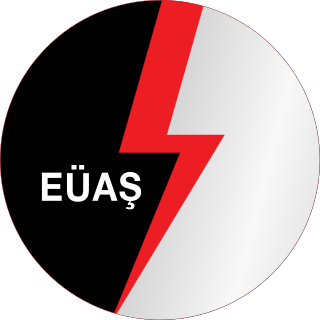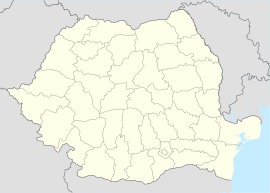
Lignite, often referred to as brown coal, is a soft, brown, combustible sedimentary rock formed from naturally compressed peat. It has a carbon content around 25–35% and is considered the lowest rank of coal due to its relatively low heat content. When removed from the ground, it contains a very high amount of moisture, which partially explains its low carbon content. Lignite is mined all around the world and is used almost exclusively as a fuel for steam-electric power generation.

Gorj County is a county of Romania, in Oltenia, with its capital city at Târgu Jiu. Gorj comes from the Slavic Gor(no)-Jiu, in contrast with Dolj.

NLC India Limited (NLC) is a central public sector undertaking under the administrative control of the Ministry of Coal, Government of India. It annually produces about 30 million tonnes of lignite from opencast mines at Neyveli in the state of Tamil Nadu in southern India and at Barsingsar in Bikaner district of Rajasthan state. The lignite is used at pithead thermal power stations of 3640 MW installed capacity to produce electricity. Its joint venture has a 1000 MW thermal power station using coal. Lately, it has diversified into renewable energy production and installed 1404 MW solar power plant to produce electricity from photovoltaic (PV) cells and 51 MW electricity from windmills.
National Company of Lignite Oltenia Târgu Jiu was set up as a commercial society by the Government of Romania in 1997. The main headquarters of the company is placed in Târgu Jiu, Gorj County.
The company has its material base in Gorj, Vâlcea and Mehedinți with total reserves of 2 billion tonnes of coal.

The Turceni Power Station is situated in Gorj County, on the banks of the Jiu River, halfway between the cities of Craiova and Târgu Jiu.

The Rovinari Power Station is one of the largest electricity producers in Romania, operating with two units and one mothballed unit of 330 MW each, thus totaling an installed capacity of 990 MW.
Romania is the 38th largest energy consumer in the world and the largest in South Eastern Europe as well as an important producer of natural gas, oil and coal in Europe.
Rovinari Coal Mine is an open-pit mining exploitation, the largest in Romania, located in Rovinari, Gorj County. The legal entity managing the Rovinari mine is the National Company of Lignite Oltenia which was set up in 1997.
Roșia – Peșteana Coal Mine is an open-pit mining exploitation, one of the largest in Romania located in Rovinari, Gorj County. The legal entity managing the Roșia - Peșteana mine is the National Company of Lignite Oltenia which was set up in 1997.
Anina Coal Mine is an underground mine that is now closed. It was one of the largest mines in Romania. It is located in South-Western Romania, in Anina, Caraș-Severin County in the historical Banat region. The mine still has large reserves of anthracite, lignite, brown coal and oil shale amounting to over 1.3 billion tonnes. It was owned by Miniera Banat a state owned company that specialised in the management of coal mines in the Banat region. The mine opened in 1790 making it the longest running mine in Romania until its closure in 2006. Its galleries are hundreds of kilometers in length and reach a depth of 1,200 metres (3,900 ft) making it the deepest mine in Romania and one of the deepest in Europe. The mine supplied oil shale to the nearby Crivina Power Station, a 990 MW thermal power station, the first oil shale power station in Romania, that had to be supplied with around 4 million tonnes of oil shale per year.

The Turów coal mine or KWB Turów, is a large open pit mine in the southwest of Poland, located outside Bogatynia, Lower Silesia. It feeds the nearby Turów Power Station. In March 2024 a Warsaw court found the EIA for mining from 2026 to be invalid, but the owner is appealing. Unlike the other coal-dependant parts of Poland, a just transition for coal phase-out has not yet been planned as of 2024.

Mátra Power Plant, is a lignite fired power plant majority owned by MVM, the Hungarian state owned power company since 2019. It is located in the valley of the Mátra mountains, in Hungary. It has an installed electric power output of 950 MW, however, one 200 MW generator has been on permanent hiatus since January 2021. According to the latest government energy strategy, most of the existing lignite-fuelled units will be shut down in 2025, and a new 500 MW gas-fired unit will be added as well as up to 400 MW in solar power.

The Electricity Generation Company is the largest electric power company in Turkey. Owned by the government, it produces and trades electricity throughout the country.
CEE Bankwatch Network is a global network which operates in central and eastern Europe. There are 17 member groups, multiple non-governmental organizations based in different locations; the network is one of the largest networks of environmental NGOs in central and eastern Europe. Bankwatch's headquarters rest in Prague, Czech Republic.

The Afşin-Elbistan power stations are coal-fired power stations in Afşin in Kahramanmaraş Province in Turkey. The area is a sulfur dioxide air pollution hotspot: Air pollution can be trapped by the surrounding mountains, and Greenpeace say that measurements they took nearby in late 2020 show illegal levels of particulates and nitrogen oxides. The Environment Ministry has not released the flue gas measurements.
Coal in Turkey generated a third of the nation's electricity in 2023. There are 55 active coal-fired power stations with a total capacity of 21 gigawatts (GW). In 2023 coal imports for electricity generation cost 3.7 billion USD.
Tufanbeyli power station is a 450 MW coal-fired power station in Turkey in Tufanbeyli, built in the 2010s, which burns lignite mined locally. The plant is 40% owned by Sabancı Holding via Enerjisa Enerji and 40% by E.ON and in 2022 received capacity payments.














